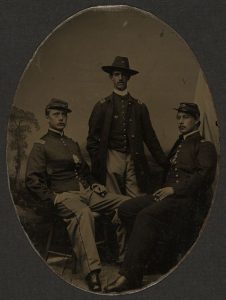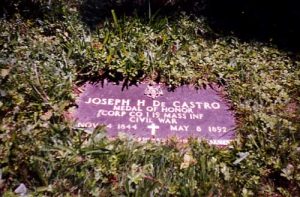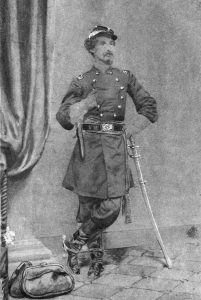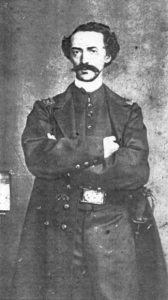Hispanic Service in the Civil War

ECW welcomes guest author Carlos Mutis
My membership with Adams County Historical Society (ACHS) has created opportunities for historical research and professional development. A recent opportunity has given me the focus of researching the role of Hispanics at the Battle of Gettysburg. This is part of a broader topic of Hispanics and our contributions to the development and history of Adams County. The idea for the project came about because ACHS is in the process of constructing two new buildings. One building will house its vast collection of artifacts in a safe and climate-controlled environment, while the other will house not only its staff but also act as a research library and museum for visitors.[1] With this in mind Executive Director Andrew Dalton suggested the research topic to me. His suggestion, coupled with the efforts of ACHS to reach out to the Hispanic community of Adams County, inspired me to do my part in the project.
The research is personal because I am both Hispanic and an immigrant. I was born in Colombia and I came to the U.S. in June of 1980. Additionally, the battle of Gettysburg has fascinated me since I was a child. Researching Hispanics at the Battle of Gettysburg was a perfect topic for me to cover. The first thing I learned was the scope of books, articles, and online resources available was more than I imagined. I thought such a topic was rarely researched or written about since it was rarely, if ever, on display at museums or mentioned in documentaries. It satisfied me greatly to see the topic of Hispanics in the American Civil War amply researched and documented.
The second thing I learned is the number of Hispanics that are believed to have participated in the war, both Union and Confederate. David Vela, former Director of the National Park Service, in his booklet titled Hispanics and the Civil War: From Battlefield to Homefront puts it at around 20,000.[2] Still, other sources like John O’Donnell-Rosales in his book Hispanic Confederates places the number of just Confederate Hispanic soldiers at a high of between 10,000 and 12,000.[3] And, in his book titled Hispanics in the U.S. Civil War: A Complete List of Men Who Fought for the Confederacy and the Union, Ricardo J. Rodriguez places the total number of Hispanics that fought in the war at about 22,000.[4] Still, the number can be even higher as many of the soldiers may have been of mixed cultures where the Hispanic surname was “daughtered” out due to marriage to a man with a non-Hispanic surname.

My favorite story so far, is that of Corporal Joseph H. De Castro, the first Hispanic in American history to earn the Medal of Honor. De Castro was flagbearer for the 19th Massachusetts Infantry Regiment. On July 3rd, 1863, during Pickett’s Charge, the 19th Massachusetts was held in reserve just south of the Copse of Trees. As the Confederate charge broke through the Union line near The Angle, Corporal De Castro, seeing the flagbearer of the 19th Virginia Infantry Regiment, and without orders to do so, charged at him.[5] Using the staff of his flag he assaulted the 19th Virginia’s flagbearer, capturing the regiment’s flag. De Castro then ran the captured flag to his Colonel, Arthur F. Devereux, handed it off and without hesitation he ran back into the fight.[6] He would be awarded the Medal of Honor on December 1st, 1863, the first of three Hispanics to earn it during the American Civil War.
Another story I must include is that of the Fernández Cavada brothers of Philadelphia. Federico and Adolfo started out together in the 23rd Pennsylvania Infantry Regiment but would serve in separate Pennsylvania infantry units by the time of the Battle of Gettysburg. Federico was born on July 8, 1831, while Adolfo was born on May 17, 1832, both in Cienfuegos, Cuba. Upon their father’s death in 1838, their mother moved back to her native Philadelphia and raised her sons there.

Federico living in a northern city came to “develop a fierce hatred of slavery.”[7] When war broke out, he enlisted in the U.S. Army and due to his education and talents as an engineer, Cavada quickly rose to the rank of Lieutenant Colonel. He switched his service to the 114th Pennsylvania Infantry Regiment in July 1862. At the Battle of Gettysburg, as part of the First Brigade, First Division, of the Third Corps, Federico led the 114th Pennsylvania at the Peach Orchard against Confederate Brigadier General William Barksdale’s Brigade. Federico was captured and sent to Libby Prison in Richmond. He was released in 1864 during a prisoner exchange. During his incarceration, he began keeping notes and drawing sketches, which he smuggled out upon his release and turned into a book entitled Libby Life: Experiences of a Prisoner of War in Richmond, Virginia, 1863-64.

Adolfo, like his brother, grew up in a city that embodied northern ideals and “was swept away by the Union cause.”[8] He joined the 23rd Pennsylvania Infantry Regiment in August of 1861, serving as Captain of Company C. Adolfo was mustered out of the 23rd Pennsylvania on July 15, 1862 to serve as an aide to Brigadier General Andrew A. Humphreys. Adolfo kept a diary during the war, and it contains detailed entries regarding his activities during the Battle of Gettysburg. The diary is held at the Historical Society of Pennsylvania and is accessible online. Both brothers would go on to serve in Cuba’s fight for independence from Spain as part of the Ten Years’ War (1868-1878). Tragically both were killed during the war for Cuban independence.
 The last, but not final, story I want to cover is that of Captain Luis F. Emilio. He was an officer with the 54th Massachusetts Infantry Regiment, the very same regiment at the center of the film Glory. Captain Emilio wrote a book about his experiences with the 54th titled A Brave Black Regiment: The History of the 54th Massachusetts, 1863-1865. He was with the 54th at the Battle of Grimball’s Landing (the hand-to-hand fight scene in Glory) on July 16, 1863 and their famous assault on Fort Wagner on July 18, 1863.[9]
The last, but not final, story I want to cover is that of Captain Luis F. Emilio. He was an officer with the 54th Massachusetts Infantry Regiment, the very same regiment at the center of the film Glory. Captain Emilio wrote a book about his experiences with the 54th titled A Brave Black Regiment: The History of the 54th Massachusetts, 1863-1865. He was with the 54th at the Battle of Grimball’s Landing (the hand-to-hand fight scene in Glory) on July 16, 1863 and their famous assault on Fort Wagner on July 18, 1863.[9]
American history is the collective story of us. We are a vast assortment of ethnicities and cultures, each with their own unique perspectives and stories to tell. Efforts to share the stories of minority groups whose stories have historically been ignored is on the rise, and is a movement I can appreciate. We can lay claim to have so many unique, vibrant, and colorful people, why would we not share their stories? It is my hope that the story of Hispanics in all aspects of American history will continue to be told so the totality of our contributions can be made evident. And, while resources related to Hispanics in the American Civil War seem ample, they are rarely displayed in a prominent location making it possible for all visitors to see. It is my hope that this will change and that sharing the spotlight with other groups will lead to greater understanding and therefore greater tolerance and unity.
My name is Carlos Mutis and I am an educator in California. I currently hold two positions in education, I work with incarcerated adults as a GED Teacher at CCI-Tehachapi and I am an Adjunct Professor of History at Cerro Coso Community College. Regarding education, I subscribe fully to the philosophy of Horace Mann that education is the great equalizer. I am not only a witness to the truth of this philosophy in my work with incarcerated adults but I myself am the embodiment of it. Regarding history, I believe that preservation and education will overcome destructive and ignorant thinking. I graduated from Norwich University in 2011 with an MA in Military History, I also have an MA in Secondary Education. I am a proud US Coast Guard veteran. I am a talented communicator who delivers succinct and thoughtful presentations that expertly translate highly-complex concepts for diverse audiences.
[1] “Capital Campaign: A Home for Your History,” Adams County Historical Society, accessed: June 15, 2021. https://www.achs-pa.org/campaign/welcome.html.
[2] David Vela, Hispanics and the Civil War: from Battlefield to Homefront (Washington, D.C.: National Park Service, U.S. Dept. of the Interior, 2012), 1.
[3] John O’Donnell-Rosales, Hispanic Confederates (Baltimore, MD: Clearfield Company, Inc., 2006), x.
[4] Ricardo J. Rodriguez, Hispanics in the Civil War: A Compiled List of Men Who Fought for the Confederacy and the Union (Scotts Valley, CA: CreateSpace Independent Publishing Platform, 2010), Back Cover.
[5] John Austin Stevens, et al., The Magazine of American History with Notes and Queries: Volume 18 (New York City: A.S. Barnes & Co., 1887), 18.
[6] “Hispanic-Americans in the Civil War.” American Battlefield Trust, accessed: June 15, 2021. https://www.battlefields.org/learn/articles/hispanic-americans-civil-war.
[7] “Hispanics and the Civil War,” National Park Service, Last updated: August 15, 2017. https://www.nps.gov/articles/hispanics-and-the-civil-war.htm
[8] “Adolfo Fernández Cavada,” American Battlefield Trust, accessed: June 15, 2021. https://www.battlefields.org/learn/biographies/adolfo-fern%C3%A1ndez-cavada
[9] Sherry Guillen, “Luis F. Emilio: Captain and Story Keeper of the 54th MA Regiment,” Last updated: December 10, 2020. https://www.nps.gov/articles/000/luis-f-emilio.htm
Carlos: I juts LOVED your article on the activities of these unknown Hispanic soldiers of the Civil War. Thank you for your article–Jim Ullman–from Williamsburg, Va.
Thank you Jim for your comments. I am glad you enjoyed my article. All the best.
Much great work being done these days on immigrants and racial minorities in the American Civil War. Thanks for the blog post. Check out Pat Young’s long running blog series The Immigrants’ Civil War and Frank de la Teja and others working on Tejanos. Also intermarriage of formerly enslaved Black Texans and Mexican peoples, not to mention Megan Kate Nelson’s astounding Three Cornered War. So many important stories to tell.
Thank you David for your comment. I will be sure to check out all of the resources you shared with me. All the best.
Thanks for your kind mention David.
Carlos, here are a few articles I have written on the Confederate invasion of New Mexico and its impact on Latinos in the territory:
https://longislandwins.com/news/national/the-confederates-move-against-latino-new-mexico/
https://longislandwins.com/news/national/the-confederate-army-in-new-mexico-strikes-at-valverde/
https://longislandwins.com/news/national/confederates-capture-santa-fe-and-plot-extermination/
Great post. I’d also add Admiral Farragut and Julius P. Garesche, among many others.
I even debated with myself adding George G. Meade because he was born in Cadiz, Spain but his parents were not Hispanic.
Just a wonderful read, and you seem a grand addition to ECW’s gallery of writers. Glad to welcome another Californian to the mix.
Thank you Meg for your kind words. All the best.
Great articie about some great Americans — many thanks … and nice to see a Norwich grad … i served with many during my career.
Thank you Mark for your comments. I’m glad to hear you served with fellow Norwich alum. All the best.